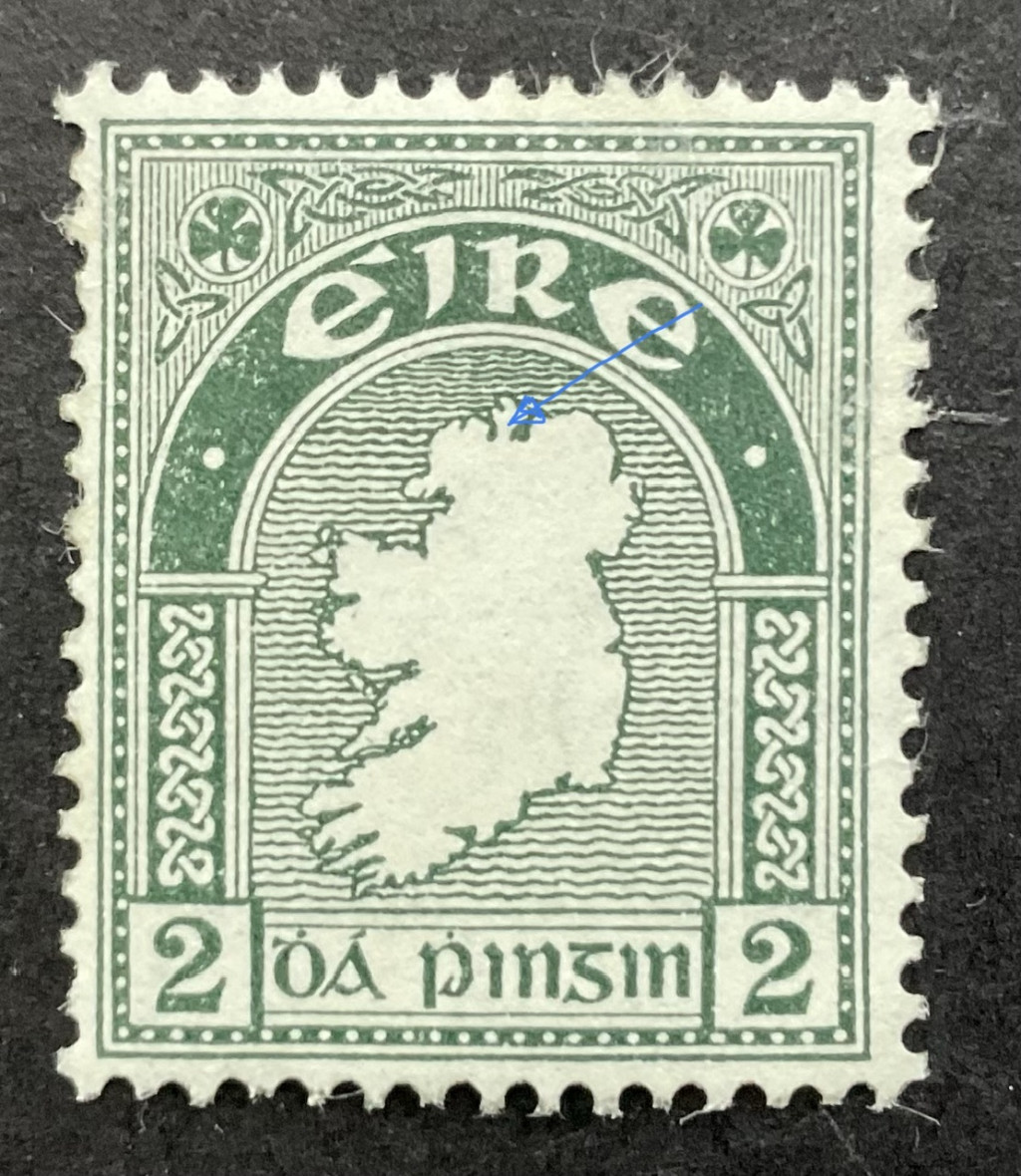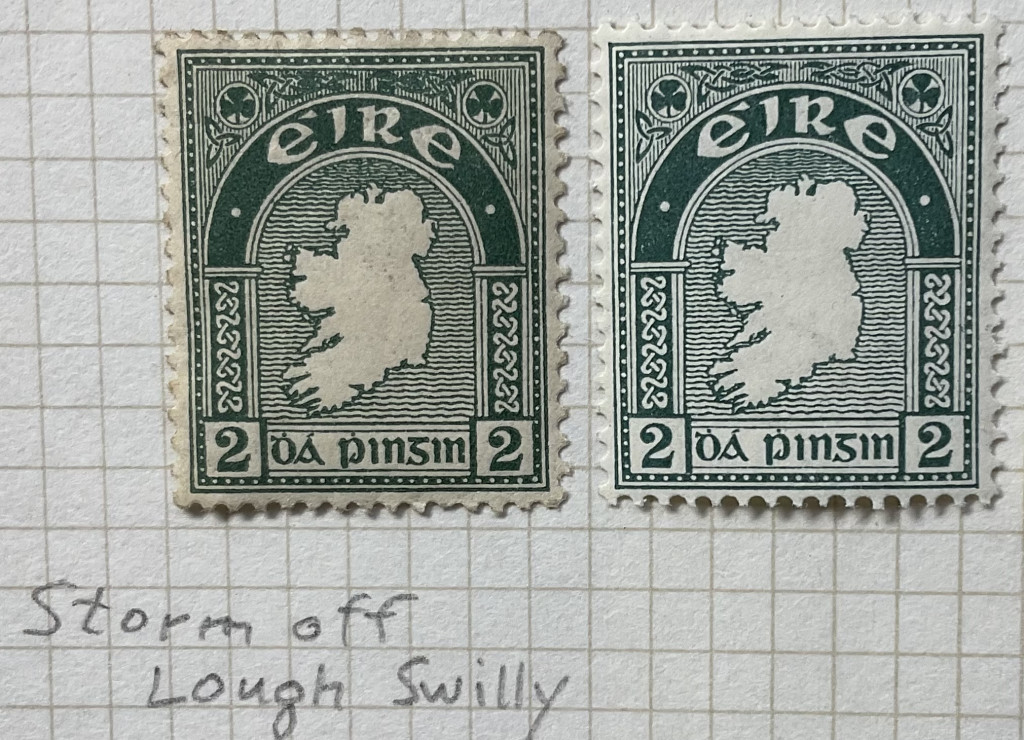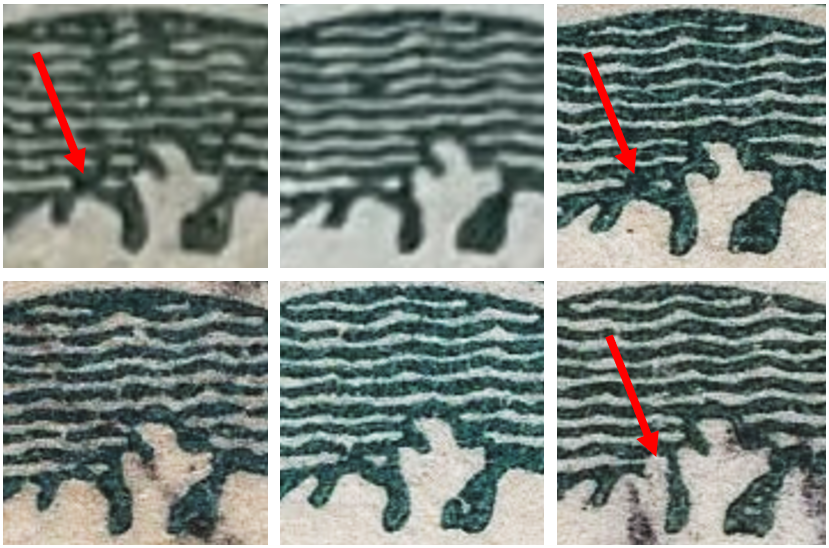philatelia
Member  Captain Jack - my best kiloware find ever!
Captain Jack - my best kiloware find ever!
Posts: 3,654
What I collect: Ireland, Japan, Scandy, USA, Venezuela, Vatican, Bermuda, Austria
|
Post by philatelia on Aug 16, 2023 23:03:22 GMT
I can’t believe as an Irish specialist that I don’t know the answer to this question; What does the “Storm off Lough Swilly” variety look like? It is mentioned in Hibernian but no pic. I suppose they think it is so common that an Irish philatelist should know what to look for. Well I don’t dagnabit! I assume it is a spot or swirl in the water off the coast, but I can’t find an example anywhere to confirm what it looks like. I have bags of these 2p greens, but I can’t part with them until this mystery is solved. I’m sure some of you can relate, eh? It should appear in the water north of the loch, yes? If you know, I’d be very grateful. Also - does anyone know where exhibitors get those arrows they use? Thanks! Blue arrow points to the Loch.  |
|
Beryllium Guy
Moderator 
Posts: 5,908  What I collect: Worldwide Stamps 1840-1930
What I collect: Worldwide Stamps 1840-1930
|
Post by Beryllium Guy on Aug 17, 2023 2:28:34 GMT
Thanks for your post, Terri ( philatelia ).... I love a quest! Disclaimer: I have no expertise in stamps of Ireland, period. But I once was a professional map reader, so I know a bit about those, and hence my presumption in responding to your post. I did a quick bit of research to find an actual map (chart) of the part of Ireland you are concerned about. I was intrigued because you were talking about a loch (seems to be spelled "lough" in Ireland), which I imagined to be a body of water, yet your blue arrow was clearly pointing to an area on the land. So, I looked for a map/chart that would show the actual location of Lough Swilly and to see if I could find that on the map shown on the 2p stamp. Please see below for my interpretation. I have added a red arrow (done in MS PowerPoint, by the way) to show where I think that the Lough Swilly should be located. I have no idea what the "storm" variety looks like, but I would suggest that this is where you should be looking. Once again, just my opinion, and others are welcome!    Edit: After additional reflection, I can see that perhaps a storm "off" Lough Swilly could be on the land, but I would further suggest, not necessarily so. The storm could be in the sea to the north. Normally, when I hear the term "off" to describe the location of something, it is "off the coast" of such-and-such. So, I am a little perplexed by the use of the word "off" in this instance, and I grant that a storm off the lough could occur on land or sea.  Map source: 4.bp.blogspot.com/_8sqFcBc5iOY/TLRm2Rl4giI/AAAAAAAAAIA/SjYOQskVGfo/s1600/Lough_Foyle_Swilly_Mulroy_Large.jpgAdded note: generally speaking, maps are drawn to show features on land, and charts are for showing bodies of water. I have used the word "map" loosely in this case, as the image I found on the internet seems to be focused on the water, which technically makes it a chart rather than a map. |
|
philatelia
Member  Captain Jack - my best kiloware find ever!
Captain Jack - my best kiloware find ever!
Posts: 3,654
What I collect: Ireland, Japan, Scandy, USA, Venezuela, Vatican, Bermuda, Austria
|
Post by philatelia on Aug 17, 2023 3:41:57 GMT
Yeah - I was using the rough scribble pen thingie for editing photos on my iPad. My blue arrow was a bit off the mark. Oopsie!
Oh forgot to add that this variety is Non Constant and is only found on the first SE watermark series.
Additional information; “a spot of color at the approximate spot on map design where Lough Swilly is located in county Donegal. Found on the lower pane of the sheet, the 12th stamp in the 17th row” from “The Revealer” July-August 1962.
corrected my spelling errors - oopsie again - sheesh
FYI the second 2p printing done in Ireland turns more bluish looking when soaked.
|
|
tobben63
Member  Stamp eat sleep repeat
Stamp eat sleep repeat
Posts: 1,874  What I collect: I collect to much, world wide!
What I collect: I collect to much, world wide!
|
Post by tobben63 on Aug 17, 2023 6:49:25 GMT
I have no idea of what the “Storm off Lough Swilly”, but I would like to know.  But for arrows and other things I use Greenshot. Here are some samples of what I can do in Greenshot.  |
|
|
|
Post by michael on Aug 17, 2023 8:21:26 GMT
There appears to be only one reference to it on the internet, The Revealer July-August 1962 edition:
|
|
Beryllium Guy
Moderator 
Posts: 5,908  What I collect: Worldwide Stamps 1840-1930
What I collect: Worldwide Stamps 1840-1930
|
Post by Beryllium Guy on Aug 17, 2023 11:38:35 GMT
Thanks to all for continuing this discussion: philatelia, tobben63, and michaelNow that I know I am looking for a spot of color somewhere near Lough Swilly, and on which watermarked paper it occurs, I will check my copies of the 2d after I get home tonight. I think I only have a handful of these, so probability is low, but I will have look. Terri, if you have a pile of these, it sounds like you have a reasonable chance of finding one. Good luck! |
|
philatelia
Member  Captain Jack - my best kiloware find ever!
Captain Jack - my best kiloware find ever!
Posts: 3,654
What I collect: Ireland, Japan, Scandy, USA, Venezuela, Vatican, Bermuda, Austria
|
Post by philatelia on Aug 17, 2023 15:36:07 GMT
Ok, here is some conflicting data. This is a pic of a page from the Robert Gray used collection that has a stamp labeled as being this variety. (I added a mint copy to the right for comparison.) He did quite a bit of work on Irish varieties and corresponded with Feldman who published an Irish specialty catalog, won a gold medal for his mint collection and won an Eire Philatelic Association award. Anyways, my point is that he knew Irish stamps quite well and if he says this is an example of the storm off Lough Swilly, then it’s probably accurate. It doesn’t look like a spot of color to me, however, more like a disruption in the water lines. So the quote from the Revealer and this notation are slightly at odds with each other. Now to corroborate with other examples. Dang, I may be nuts, but I love flyspecking.  |
|
Beryllium Guy
Moderator 
Posts: 5,908  What I collect: Worldwide Stamps 1840-1930
What I collect: Worldwide Stamps 1840-1930
|
Post by Beryllium Guy on Aug 17, 2023 18:19:18 GMT
Interesting, Terri ( philatelia)! Thanks for posting that. Well, now I know what to look for, and at least based on the name of the variety, it makes sense (at least to me), that the storm off the lough is over the sea, rather than on the land. We are at the airport now, and I will check when I get home tonight. |
|
Beryllium Guy
Moderator 
Posts: 5,908  What I collect: Worldwide Stamps 1840-1930
What I collect: Worldwide Stamps 1840-1930
|
Post by Beryllium Guy on Aug 20, 2023 20:15:06 GMT
Terri ( philatelia), I have just checked my 2p stamps, a grand total of four copies (!), but it looks like one of them may be a candidate for ink spots in the sea to the north of Lough Swilly, but honestly, I am not sure. I will do a 600dpi scan later on and post images for you and everyone to see and assess.    |
|
Beryllium Guy
Moderator 
Posts: 5,908  What I collect: Worldwide Stamps 1840-1930
What I collect: Worldwide Stamps 1840-1930
|
Post by Beryllium Guy on Aug 20, 2023 23:05:36 GMT
"Storm Off Lough Swilly" Small StudyOK, Terri ( philatelia), I have finally put this together. Sorry, it took me some time. Please see caption below for detailed descriptions in the composite image. As with Cape Triangles, I find side-by-side comparison to be invaluable. Also, I ended up needing to scan at 1200dpi, as the 600dpi images just didn't seem to show enough detail to make the comparisons.  Top Row Top Row: Left: Close-up of Robert Gray's labelled image from Terri's collection (red arrow points to deep color spot) Middle: Close-up of the other stamp image from Terri's collection Right: Close-up of stamp from my collection that seems to show a rather deep spot of color similar to the Gray image (red arrow) Bottom Row: Left: Close-up of stamp from my collection that shows more breaks in the waves but no deep spot of color Middle: Close-up of another stamp from my collection that shows nothing in particular Right: Perhaps most interesting is this example from my collection that seems to show additional land mass instead of a color spot! This is what I found with my meager accumulation of four copies of this stamp. If the Storm Off Lough Swilly is based on one large color spot, then perhaps my stamp at far right in the top row has a chance. If more color spots are needed in the sea, then I think it falls short. Those are just my observations, and I am admittedly a novice at flyspecking, so interested in hearing other opinions....
|
|
salentin
Member  collecting Germany,where I live and about 20 more countries,half of them in Asia east of the Indus
collecting Germany,where I live and about 20 more countries,half of them in Asia east of the Indus
Posts: 6,503  Member is Online
Member is Online
|
Post by salentin on Aug 22, 2023 17:59:24 GMT
My "pool" of the 2 P. SE-wmk is even smaller: 3 One,unfortunately a used copy,shows a dot in the sea not far from the coast down under the straight down line of the R of "eiRe".Not easy to spot,because of the cancellation.
But I have a feeling,that this is a stamp-issue,with many,many minor flaws.
Reminds me of Germany,where few decades ago fly-specking was very popular.
From almost every newly issued stamps many such flaws were recorded and sent to
the Bundesdruckerei (federal printing works) in Berlin for confirmation.What was duly given.
A reputable stamp-dealer ran an advertisement at the time,offering stamps guaranteed "flaw-free".
The whole run cooled down,when Michel announced,that they would no longer list minor flaws,
but only those,what are clearly visible with the "naked,un-aided" eye.
|
|
philatelia
Member  Captain Jack - my best kiloware find ever!
Captain Jack - my best kiloware find ever!
Posts: 3,654
What I collect: Ireland, Japan, Scandy, USA, Venezuela, Vatican, Bermuda, Austria
|
Post by philatelia on Aug 22, 2023 20:46:34 GMT
Great posts, salentin and Beryllium Guy . I’ve just started to study the 2p green myself and, yes, these first issues are a goldmine of minor varieties. Chris, your extra dot of land - hmmmm - I see no mention in my literature but that doesn’t mean it’s not a fun find - very cool! I’ll let you know if I come across another. Finding multiples copies with the same variety is very good news - which leads to the next paragraph on constants. The thing with flyspecking is something called “constant”. For our newer collectors, a constant variety always shows up in the same position on every sheet, for example the 2nd row 3rd stamp in would show up in the catalog as 2/3. N/C means it doesn’t show up in the same location. Constants will be easier to find because if there is one on every sheet, then if there are 100 stamps in the sheet then obviously 1/100 will have that variety. N/Cs can be much more elusive. Varieties can show up all over the place - all sorts of little scratches, flaws, missing spots, broken letters or lines, retouches, re-entries and many other critters. If you find one try to describe it in detail and use arrows and sketches to help others who read your notes to know what to look for. It’s helpful to put a plain copy adjacent to the variety for comparison. Some collectors place them on the same page as their regular issues, some put varieties in a separate section. I personally prefer to put them together. EDIT - Access to full sheets is a huge advantage, but not necessary. |
|